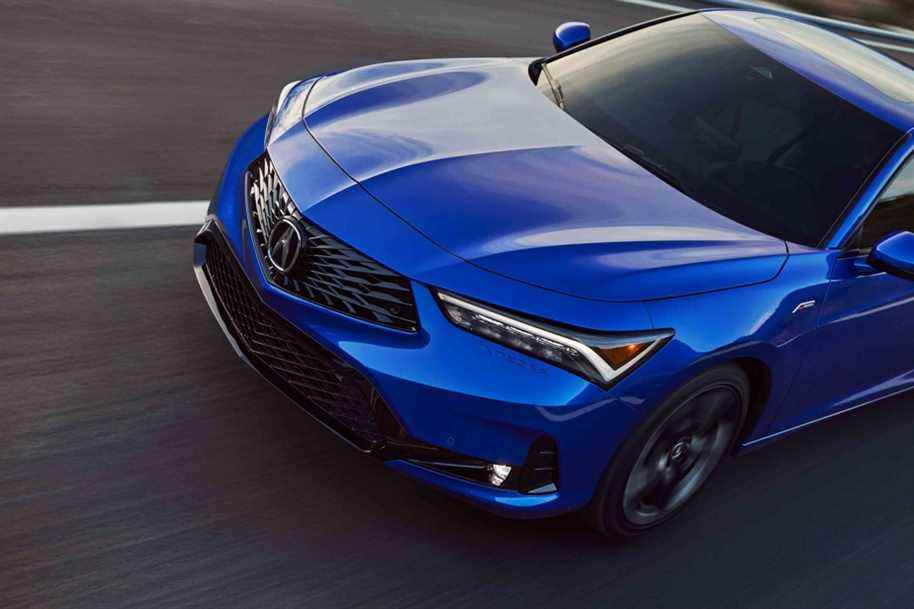Posted at 11:45 a.m.
Acura Integra
Let’s be honest and polite, the return of the Integra arouses mixed opinions. We like it or we don’t like it. One thing is certain, the revival of this model is a fine example of what is called generational marketing. Welcomed freshly by the faithful of the founding model, this reincarnation would be, to hear them, only a pale imitation, no more. Acura management takes note of these insinuations, but promises that enthusiasts will not be disappointed, far from it, by the dynamic performance of this vehicle.
Honda HR-V

PHOTO PROVIDED BY HONDA
Honda HR-V
Oh how he has grown! More wrapped, the second generation of the HR-V deposits its bodywork on an architecture derived from that of the current Civic (compact). For the record, the founding model married the Fit (subcompact) platform. For now, Honda does not say a word about the engine, limiting itself to saying that “it will be more reactive”. The mystery will soon be lifted, the marketing of this vehicle will begin in the summer. The launch of the HR-V precedes the renewal of the CR-V and Pilot, the first rounds of which are scheduled for the fall.
Mercedes SL

PHOTO PROVIDED BY MERCEDES-BENZ
Mercedes-AMG SL 55 4Matic+
The only new addition to the convertible section this spring, the Mercedes SL is not a car you should expect to see on every street corner. Rare, this object is built at a pace closer to craftsmanship than industrial rates. Plush and energetic, the SL plays wonderfully on the opposition between its endless bonnet and its compact, pointed rear. Quietly, the interior has a few charming surprises in store, such as two additional seats (for two young children) and multimedia screens. Everything is now covered with a canvas and not a hard roof.
Genesis GV60

PHOTO PROVIDED BY GENESIS
Genesis GV60
And three. After the Ioniq 5 and the Kia EV6, the GV60’s turn to make use of the E-GMP electrical architecture designed by the Hyundai group. The luxury brand of Hyundai has not released relevant details on the Canadian version of this model so far. In fact, all the characteristics revealed of this model called to compete with the Audi Q4 and other Volvo C40 are those of the South Korean model.
Kia Sportage

PHOTO PROVIDED BY KIA
Kia Sportage SX and X-Pro
Visually speaking, the new Sportage is not lacking in audacity. But beyond its unusual visual signature, this utility intends to stand out from the competition by offering more interior clearance – especially at the rear – and a larger trunk than the previous version. Technically, the Sportage offers three engines, including two hybrids. As part of its Canadian launch, this model will not have, unlike the United States, X-Pro versions, which are intended for off-road use.
Mazda CX-50

PHOTO MITCHELL HUBBLE, PROVIDED BY MAZDA
Mazda CX-50
Mazda makes no secret of its intention to join the fine linen industry. With the CX-50, Mazda is targeting the Acura, Infiniti and Lexus of this world by offering a versatile utility with a neat presentation. Before going further, it is important to specify that the CX-50 is not a CX-5 dressed up. The architecture is totally different, even if the exterior dimensions suggest otherwise. The CX-50 offers more cargo space, claims to be able to tow a heavier load (GT Turbo) and doesn’t mind getting its rims dirty.
Nissan Z

PHOTO PROVIDED BY NISSAN
Nissan Z
At a time when automotive novelties are photocopying themselves, the arrival of a brand new Z at Nissan lifts your spirits. Yes, the pleasure car still exists. Its twin-turbocharged V6 engine produces 400 hp to the rear wheels through a six-speed manual transmission. A nine-speed automatic is also offered. The buyer will also have to choose from a range of options, including a limited-slip differential and beefier brake calipers.
Subaru WRX

PHOTO PROVIDED BY SUBARU
Subaru WRX
The STi will have no descendants, but the WRX will. This is enough to put a balm to the hearts of lovers of financially accessible high-performance cars. And there are plenty of them this year. To stand out, the WRX relies on its full-time all-wheel drive, its 271-hp supercharged flat engine and its stiffer, more modern chassis. Subaru still has a manual transmission in its catalog, but the continuously variable automatic (CVT) promises not only to be the fastest, but also the most sophisticated. Indeed, it is accompanied by devices that can configure driving.
Toyota Bz4X

PHOTO PROVIDED BY YOYOTA
Toyota Bz4X
Rational or cautious for some, cautious, even refractory, for others. However, on reflection, Toyota’s electric strategy takes into account the realities in the approximately 170 countries where the brand is represented and the fact that the future is being prepared by not neglecting any option. At the time of writing these lines, a publication ban prevents us from saying more about the autonomy of the Toyota Bz4X and the main characteristics of this model which will begin its commercial career in June.
Volvo C40 Refill

PHOTO PROVIDED BY VOLVO
Volvo C40 Refill
Traditionally, Volvo uses the letter C to identify the coupés in its range. Every rule has its exception. Despite the curve of its roof, the C40 Recharge has five openings. This model, closely derived from the XC40 small utility, has two electric power units (which therefore makes it an all-wheel drive) whose power totals 402 hp. The presumed autonomy is 360 km, according to its manufacturer. Unlike the XC40 Recharge, only one version exists in the C40 Recharge catalog.

